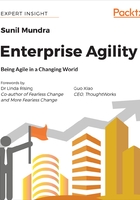
Agility is a necessity
I am a passionate believer in the need for agility (the use of noncapital "a"; in agility is deliberate as it's a capability and not a noun) at the enterprise level. Being an evangelist for enterprise agility, I believe that it's the only agility that will enable enterprises not only to deal with a fast changing environment, but more importantly to leverage change for competitive advantage and customer delight. The reason I say this with full conviction is that, in my opinion, this is the common attribute of enterprises that are successfully dealing with and/or leveraging change, be it large corporations such as Google and Amazon or newer start-ups such as Uber and Tesla, which are causing widespread disruptions. My conviction is validated not only by the virtue of me being a part of an organization— ThoughtWorks—which has achieved a mature and sustainable level of agility across the globe
My sentiment about agility is aligned with what Jim Highsmith, one of the signatories of the Agile Manifesto, has said: "Agility is the ability to both create and respond to change in order to profit in a turbulent business environment." (http://jimhighsmith.com/what-is-agility/)
It is an indisputable fact that the Agile Manifesto and its twelve Principles were abstracted from the methodologies such as Scrum, XP, and DSDM, which were being used to overcome software-delivery-related problems. However, I am very sure that the Agile Manifesto signatories intended the outcome to be agility, and not just following Agile as a methodology. This difference is extremely significant and goes beyond nuances of grammar. It's about "being" Agile: having agility versus "doing" Agile.
While I will deal with the issue of Agile versus agility at length in the core of the book, my hypothesis is that most Agile Transformations initiated—by adopting Agile at enterprise level—have met with limited success because the focus has been on "doing" rather than on "being" Agile. Compared with Agile, agility is a very different ballgame. This is because it's intrinsic in nature and so applies to the whole and not to just one or more parts of the whole. To give an analogy, "doing" Agile is akin to mechanically lifting weights to strengthen the arms, and "being" Agile is about aligning the physical body, mind, and emotions to improve the holistic health of a person. Sure, it may need to include lifting weights to strengthen the arms, but it may also include overarching things such as giving up smoking, practicing meditation, and improving work-life balance.
My experience and reading suggests that leaders who have taken their enterprises down the Agile Transformation path have often found that achieving enterprise agility is hard, scary, and painful. Moreover, the illusion that agility can be achieved merely based on scaling Agile practices and processes across teams is not helping the cause at all. Unless the enterprise achieves real agility, the benefits gained from "doing" Agile will at best be very limited and will most likely regress the concerned parts of the enterprise to their original dysfunctional state.
It's therefore not surprising that leaders of such enterprises are unable to see the full potential of agility, and at times, have actually lost faith in it. On the other hand, leaders who have had the courage, conviction, and persistence to transform the enterprise and themselves as well, have experienced incredible outcomes.